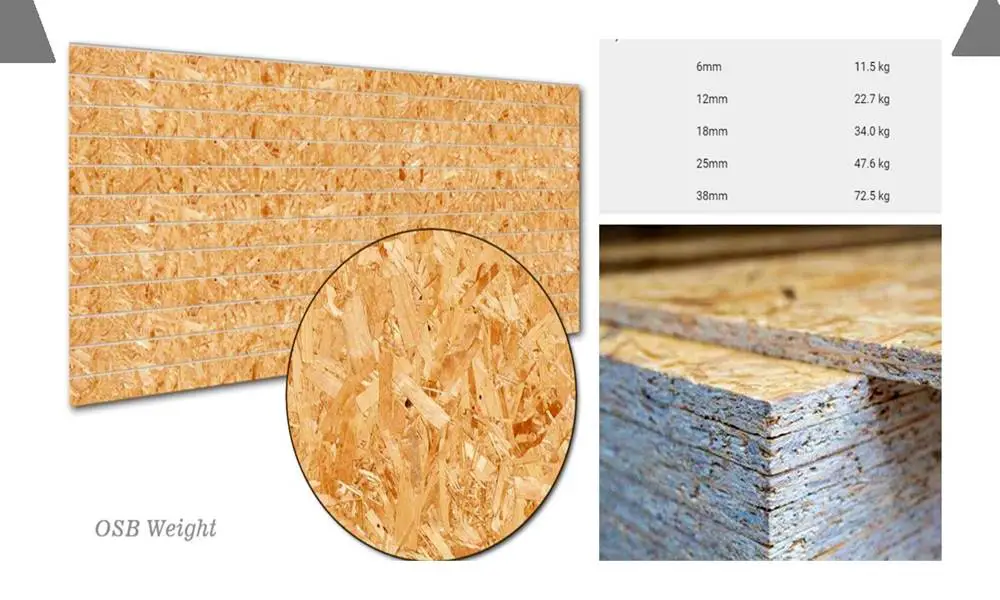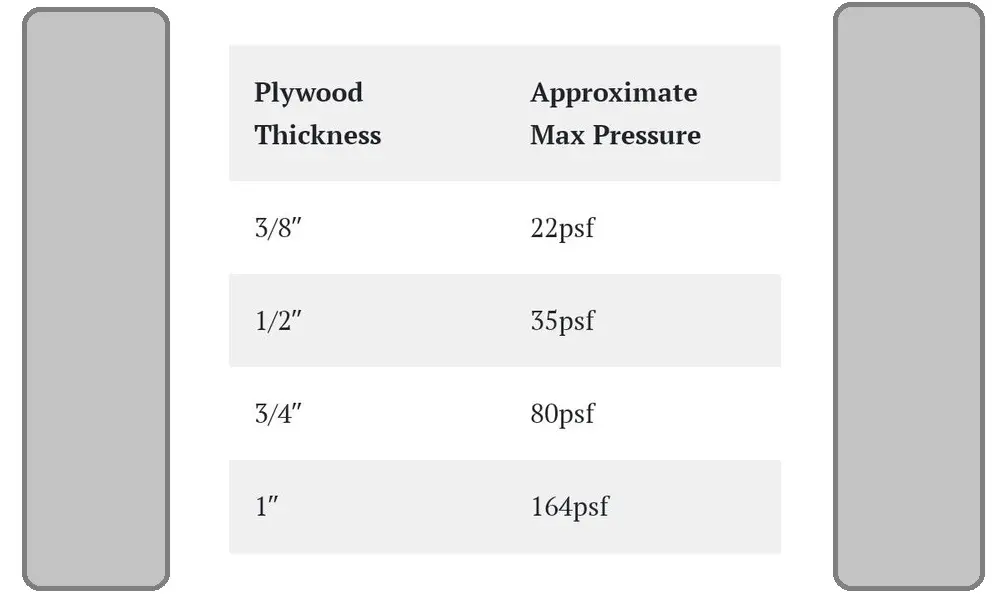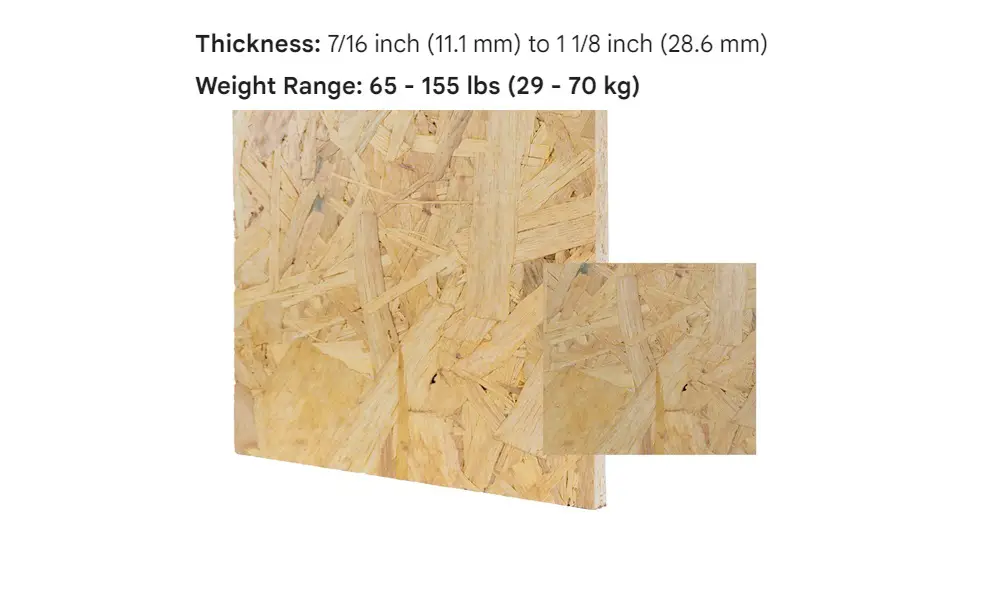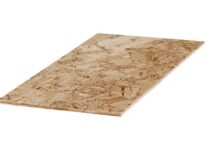How Much Does OSB Weigh

When it comes to construction materials, knowing the weight of each component is crucial for planning and execution. In this comprehensive guide, I delve into the weight of Oriented Strand Board (OSB), exploring its variations based on thickness and size. Whether you’re a seasoned builder or a DIY enthusiast, understanding how much OSB weighs can streamline your construction process and ensure optimal results.
Why OSB Weight Varies
The weight of an OSB (Oriented Strand Board) board isn’t constant; it fluctuates due to various factors, primarily influenced by its dimensions and density. Let’s delve into why this variation occurs:
Variety in Sizes
OSB is available in a range of thicknesses, typically spanning from 7/16 inches to 1 1/8 inches. Additionally, standard sizes like 4×8 feet (1220 x 2440 mm) are common. The size of the board directly impacts its volume, consequently affecting its overall weight. A larger board with greater dimensions will naturally weigh more than a smaller one due to its increased volume.
Density Variations
Although the average density of OSB is around 0.0231 lbs/in^3 (37 kg/m^3), slight discrepancies may arise depending on the manufacturer and the specific type of board. These density variations stem from differences in the manufacturing process, quality of materials used, and even environmental factors. As a result, OSB boards from different sources may exhibit slight variations in density, thereby leading to fluctuations in their overall weight.
Estimating OSB Weight

When it comes to accurately estimating the weight of an OSB (Oriented Strand Board) board, there are specific methods and considerations to take into account. Here are two primary approaches:
Use an OSB Weight Calculator
Utilizing online OSB weight calculators is a convenient and reliable method to estimate the weight of a particular OSB board. These calculators allow users to input specific data such as the board’s thickness, length, width, and density.
By incorporating the average density of OSB (typically around 0.0231 lbs/in^3 or 37 kg/m^3), these tools provide a close approximation of the board’s weight. This method is particularly useful for obtaining quick estimates without the need for complex calculations.
Check Manufacturer Information
Many OSB manufacturers offer detailed product information on their websites or product packaging, including data related to the board’s weight. By consulting these official sources, builders and contractors can access accurate and reliable information regarding the weight of a particular OSB board variant.
This information may include specific details about the board’s dimensions, density, and corresponding weight. Manufacturers often conduct thorough testing and analysis to provide precise weight data, ensuring customers have the necessary information for their construction projects.
General Weight Range

For a standard 4×8 feet (1220 x 2440 mm) OSB board with a thickness of 7/16 inch (11.1 mm) and an average density of 0.0231 lbs/in^3, the estimated weight typically falls within the range of 65-70 pounds (29-32 kg).
It’s crucial to understand that this estimation serves as a guideline, and actual weights may vary slightly based on specific density and dimensions. Variations in manufacturing processes, wood quality, and environmental factors can influence the precise weight of each board.
OSB Weight in Imperial Measurements
In imperial sizing, the weight of OSB sheets varies significantly depending on their thickness. Here’s a breakdown of the approximate weights for different thicknesses:
- 1/4″ thickness: Approximately 26.55 lbs
- 5/16″ thickness: Around 33.19 lbs
- 1/2″ thickness: Roughly 53.10 lbs
- 3/4″ thickness: About 79.65 lbs
- 1-1/8″ thickness: Nearly 119.47 lbs
As the thickness increases, so does the weight of the OSB sheet. Builders and contractors must consider these weight differences when selecting OSB for their projects to ensure structural integrity and proper handling.
You need to know this:
OSB Weight in Metric Measurements
For those working with metric measurements, the weight of OSB sheets follows a similar pattern based on thickness. Here’s a summary of the approximate weights for various metric thicknesses:
- 6mm thickness: Around 11.5 kg
- 12mm thickness: Almost 22.7 kg
- 18mm thickness: Approximately 34.0 kg
- 25mm thickness: Roughly 47.6 kg
- 38mm thickness: Nearly 72.5 kg
Similarly to imperial measurements, thicker OSB sheets exhibit higher weights in metric units. Understanding these weight variations is essential for builders and contractors worldwide, as it facilitates informed decision-making during the construction process.
| Thickness (Imperial) | Approximate Weight (lbs per 4-ft x 8-ft sheet) | Thickness (Metric) | Approximate Weight (kg per 2440mm x 1220mm sheet) |
|---|---|---|---|
| 1/4″ | 26.55 lbs | 6mm | 11.5 kg |
| 5/16″ | 33.19 lbs | 12mm | 22.7 kg |
| 1/2″ | 53.10 lbs | 18mm | 34.0 kg |
| 3/4″ | 79.65 lbs | 25mm | 47.6 kg |
| 1-1/8″ | 119.47 lbs | 38mm | 72.5 kg |
Comparison with Other Materials
When comparing OSB to other widely used construction materials, such as softwood plywood and Medium Density Fiberboard (MDF), several key differences in weight become apparent:
OSB vs. Softwood Plywood
OSB is approximately 31% heavier than softwood plywood. This weight disparity arises due to differences in composition and manufacturing processes. While both materials serve similar purposes in construction, the structural properties and weight variations impact their suitability for specific applications.
Builders must consider these differences when selecting between OSB and softwood plywood for their projects, taking into account factors such as load-bearing requirements and installation logistics.
OSB vs. Medium Density Fiberboard (MDF)
On the other hand, OSB is about 9% lighter than Medium Density Fiberboard (MDF). MDF is a composite wood product made from wood fibers bonded together with resin under high pressure and temperature. Despite its lighter weight compared to OSB, MDF offers its unique set of advantages, including smooth surface finish and ease of machining.
Builders weighing the options between OSB and MDF must assess factors such as structural integrity, moisture resistance, and finishing requirements to determine the most suitable material for their specific project needs.
Conclusion
Understanding the weight variations of OSB based on thickness, size, and comparison with other materials is crucial for anyone involved in construction projects. By gaining insight into How Much Does OSB Weigh, builders can make informed decisions regarding material selection, handling, and installation.
Whether constructing walls, subfloors, or roof sheathing, having a clear understanding of OSB’s weight ensures a successful and efficient building process. Comparing OSB to alternative materials like softwood plywood and MDF provides valuable context for evaluating trade-offs and selecting the most appropriate material for each project’s requirements.
Informed decision-making based on comprehensive knowledge empowers builders to achieve optimal results and uphold the highest standards of quality and safety in construction endeavors.
FAQs
How do I calculate the weight of a specific OSB board?
To calculate the weight accurately, use an OSB weight calculator or refer to manufacturer-provided information for the specific board variant.
What factors influence the weight of OSB?
The weight of OSB depends on its dimensions (length, width, thickness) and density, which can vary based on manufacturer and board type.
Is OSB heavier than plywood?
Yes, OSB is generally heavier than softwood plywood but lighter than materials like Medium Density Fiberboard (MDF).
Can I use OSB weight information for structural calculations?
While OSB weight information is essential for handling and installation purposes, structural calculations require additional considerations beyond weight alone.
Where can I find accurate weight information for specific OSB boards?
You can find weight information on OSB manufacturer websites or product packaging, or utilize online OSB weight calculators for estimates.


